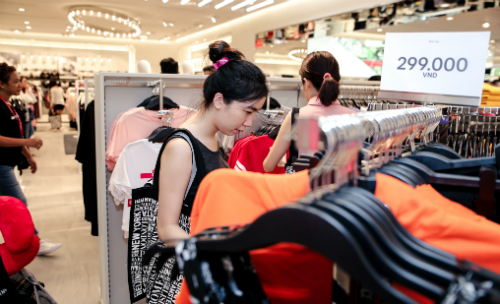Vietnamese Fashion Brands Wither Away As Designs Remain Stagnant


Youth are willing to spend more money on foreign made products
Seeing a dress at Zara, Ngan, a bank officer, promptly decided to buy it for her daughter’s birthday, though the product was priced at VND800,000.
The same amount of money could buy three Vietnamese-made products. However, she chose the dress as she really liked the new design.
There are three groups in the world market, including powerful economies like the US, cultural center with deep value like Italy and France, and markets with specific character like Japan and South Korea. |
Ngan’s choice shows a growing tendency in Vietnam: youth are willing to spend big money to buy foreign-made products instead of Vietnamese.
This coincides with a Nielsen report which shows that Vietnamese rank third in the world, after China and India, in terms of passion for branded goods.
Vietnamese fashion brands, such as Foci of Nguyen Tam Fashion Company, NinoMaxx of Thoi Trang Viet, BlueExchange of Xanh Co Ban Fashion, and PT2000 of Pham Tuong 2000 Company, once controlled the domestic market in early 2000.
Of these, Foci has disappeared, and others have lost their positions in the market.
Launched in 1999, Foci reaped big success in the mid-end market segment. Just eight years after the establishment day, it had 60 shops in large cities. However, it had to leave the market six years later in 2012 because of the landing of abnormally cheap Chinese products.
Meanwhile, Ninomaxx, Viet Thy and BlueExchange have struggled. Thoi Trang Viet’s network, which once had 200 shops across the country, has shrunk, and it had to ‘declare death’ for Maxx Style, one of the three product lines targeting low-end customers.
Meanwhile, on May 10, Viet Tien and An Phuoc, the other strong brands, began mostly operating in the small market segment of products for office workers.
“Vietnamese fashion companies need more money and a character of their own,” said Le Tien Truong, CEO of Vinatex, when asked how to help Vietnamese brands survive the competition with foreign brands.
“Vietnam is capable of making the types of products that Zara or H&M are selling in the Vietnamese market at the production cost just equal to 60 percent. However, the problem lies in the positioning of Vietnam’s fashion industry on the world’s map,” he said.
According to Truong, there are three groups in the world market, including powerful economies like the US, cultural center with deep value like Italy and France, and markets with specific character like Japan and South Korea.
Truong said the problem is that Vietnamese companies have not found the way to create their original character.
RELATED NEWS
How are Vietnamese fashion brands faring?
Domestic fashion brands seek foothold in $3.5 billion market
Mai Nam
Vietjet Launches Four Routes Linking Top Destinations Of Việt Nam And India
Vietjet has officially launched four more services linking top destinations of Việt Nam and India including HCM Ci... Read more
Sacombank To Recruit 300 Staff By July
Sacombank is set to hire 300 employees by the end of July for positions like personal/corporate customer service ass... Read more
"Fly First-Pay Later" By MOVI And Vietjet Wins Technology Award
“Fly first - Pay later” is an 100 per cent online financial product that first appeared on the Vietnamese market... Read more
EXIM Thailand Opens Representative Office In HCM City, Inks Credit Deal With BIDV
The Export-Import Bank of Thailand has agreed to provide the Bank for Investment and Development of Việt Nam with ... Read more
Vietjet Launches Two Routes To India
The two newest routes, which will operate 3 and 4 round-trip flights per week respectively, are expected to continu... Read more
Vietjet Develops E-logistics, Pays 20 Per Cent Stock Dividend
The budget carrier expects to earn more than VNĐ22.3 trillion (US$959 million) in air transport revenue in 2022 Read more

